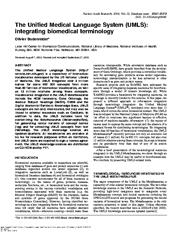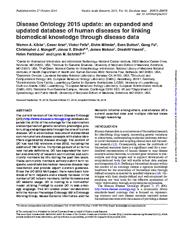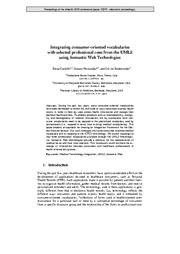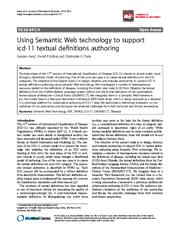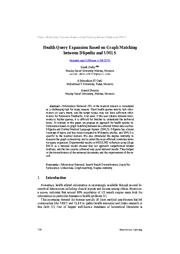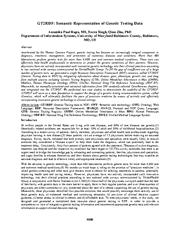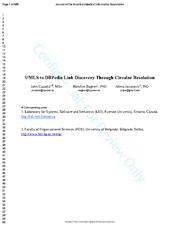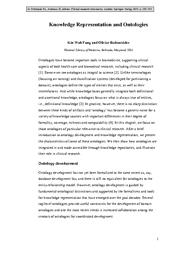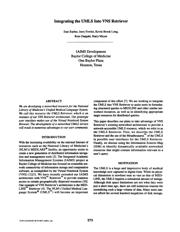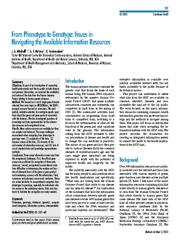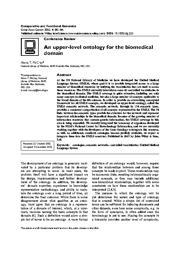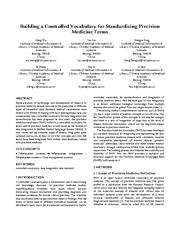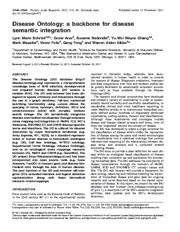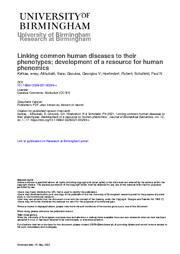A copy of this work was available on the public web and has been preserved in the Wayback Machine. The capture dates from 2018; you can also visit the original URL.
The file type is application/pdf.
Filters
The Unified Medical Language System (UMLS): integrating biomedical terminology
2004
Nucleic Acids Research
UMLS concepts are not only inter-related, but may also be linked to external resources such as GenBank. ...
The UMLS integrates over 2 million names for some 900 000 concepts from more than 60 families of biomedical vocabularies, as well as 12 million relations among these concepts. ...
Finally, in addition to intra-Metathesaurus links, external cross-references allow UMLS users to bridge between terminologies in the UMLS and external resources. ...
doi:10.1093/nar/gkh061
pmid:14681409
pmcid:PMC308795
fatcat:k3ybxv3qhvenpjo6cl4cgeuyby
Disease Ontology 2015 update: an expanded and updated database of human diseases for linking biomedical knowledge through disease data
2014
Nucleic Acids Research
protein, drug and epitope data through the lens of human disease. ...
DO is a biomedical resource of standardized common and rare disease concepts with stable identifiers organized by disease etiology. ...
We appreciate and thank everyone who has used the DO website and the Disease Ontology, provided suggestions, corrections and improvements for DO over the years. ...
doi:10.1093/nar/gku1011
pmid:25348409
pmcid:PMC4383880
fatcat:b2dpphbncbdi5bv6paspxcveoy
Integrating Consumer-Oriented Vocabularies with Selected Professional Ones from the UMLS Using Semantic Web Technologies
[chapter]
2011
Lecture Notes of the Institute for Computer Sciences, Social Informatics and Telecommunications Engineering
We exploit mappings to four other professional vocabularies available through the UMLS Metathesaurus. ...
Semantic Web technologies provide a platform for the representation of medical terms and their inter-relations. ...
UMLS attributes; 3) Load these resources into a Triple Store; and 4) Explore relations among terms, through SPARQL queries. ...
doi:10.1007/978-3-642-23635-8_7
fatcat:a7qwq7x3wfg6jmdbjyroyhq7mi
Using Semantic Web technology to support icd-11 textual definitions authoring
2013
Journal of Biomedical Semantics
We investigated a number of heterogeneous resources related to the definitions of diseases, including the linked open data (LOD) from DBpedia, the textual definitions from the Unified Medical Language ...
The beta phase of the 11 th revision of International Classification of Diseases (ICD-11) intends to accept public input through a distributed model of authoring. ...
We investigate a number of heterogeneous resources related to the definitions of diseases, including the linked open data (LOD) from DBpedia, the textual definitions from the Unified Medical Language System ...
doi:10.1186/2041-1480-4-11
pmid:23601451
pmcid:PMC3653695
fatcat:qawsrowoczg3pdnbs53qklattu
Using semantic web technology to support ICD-11 textual definitions authoring
2012
Proceedings of the 4th International Workshop on Semantic Web Applications and Tools for the Life Sciences - SWAT4LS '11
We investigated a number of heterogeneous resources related to the definitions of diseases, including the linked open data (LOD) from DBpedia, the textual definitions from the Unified Medical Language ...
The beta phase of the 11 th revision of International Classification of Diseases (ICD-11) intends to accept public input through a distributed model of authoring. ...
We investigate a number of heterogeneous resources related to the definitions of diseases, including the linked open data (LOD) from DBpedia, the textual definitions from the Unified Medical Language System ...
doi:10.1145/2166896.2166910
dblp:conf/swat4ls/JiangSC11
fatcat:v3an3cphvjfc3ggnlyqvdbzpyi
Health Query Expansion based on Graph Matching between DBpedia and UMLS
2021
International Journal of Online and Biomedical Engineering (iJOE)
In contrast, in this paper, we propose an approach for health queries reformulation based on graph matching between two external linked data sources: DBpedia and Unified Medical Language System (UMLS). ...
DBpedia has a broad coverage of topics and less noise compared to Wikipedia articles, and UMLS is specific to the medical domain. ...
Query reformulation through the combination of multiple information sources has a better effectiveness compared to the use a single information source [10] . ...
doi:10.3991/ijoe.v17i06.22755
fatcat:7tfrig2vy5borbzslejihf37di
GT2RDF: Semantic Representation of Genetic Testing Data
2017
AMIA Annual Symposium Proceedings
about disease, gene, phenotype, genetic test, and drug from multiple sources including Genetic Testing Registry (GTR), Online Mendelian Inheritance in Man (OMIM), MedGen, Human Phenotype Ontology (HPO ...
To fill the gap of insufficient use of a large number of genetic tests, we generated a single Resource Description Framework (RDF) resource, called GT2RDF (Genetic Testing data to RDF) by integrating information ...
Methods In this study, we generated an integrative and standardized data resource for genetic test via multiple steps, 1) we semi-automatically collected genetic testing relevant data from multiple resources ...
pmid:28269903
pmcid:PMC5333271
fatcat:r5of4xythnaabhiufgtgd22vem
UMLS to DBPedia link discovery through circular resolution
2018
JAMIA Journal of the American Medical Informatics Association
Conclusion: The proposed circular resolution method is a simple yet effective technique for linking UMLS concepts to DBpedia resources. ...
Objective: The goal of this work is to map UMLS concepts to DBpedia resources using widely accepted ontology relations including skos:exactMatch, skos:closeMatch, and rdfs:seeAlso, as a result of which ...
However, our technique may return multiple skos:exactMatch links for a single UMLS concept. ...
doi:10.1093/jamia/ocy021
pmid:29648604
fatcat:6bbmeyap2fgrbh346ccei6c62u
Knowledge Representation and Ontologies
[chapter]
2012
Health Informatics Series
Ontologies are key enabling resources for the Semantic Web, the "web of data", where resources annotated in reference to ontologies can be processed and linked automatically [12]. ...
While continuants exist (endure) through time, occurrents go through time in phases. ...
There is also a disease hierarchy to which drugs may be linked through roles such as may_treat, may_prevent and may_diagnose. NDF-RT contains about 4,000 drugs at the ingredient level. ...
doi:10.1007/978-1-84882-448-5_14
fatcat:r7e2fbulcrcddpxh7jo6lu77wa
Integrating the UMLS into VNS Retriever
1992
Proceedings. Symposium on Computer Applications in Medical Care
We call this resource the UMLS Retriever, which is an instance of our VNS Retriever architecture. Our prototype user interface makes use of the Virtual Notebook System Browser. ...
We are developing a networked resource for the National Library of Medicine's Unified Medical Language System. ...
Given the goal of finding all gernane references within a WAIS service, multiple queries employing different phrasing might improve retrieval on WAISindexed resource. Related Work. ...
pmid:1482881
pmcid:PMC2248017
fatcat:mtb2uk7t7bcgho3vxti55i6bda
From phenotype to genotype: issues in navigating the available information resources
2003
Methods of Information in Medicine
relating to human genetic diseases. ...
We focused on a set of single gene diseases selected from main topics in MEDLINEplus, the NLM's principal resource focused on consumers. ...
Figure 1 illustrates the path through the information resources used to answer the questions about Marfan syndrome; the traversal was from the consumer health resources through disease-related resources ...
pmid:14654891
pmcid:PMC1800828
fatcat:mk6tkz2dofcrzjjm2b5jideliy
An Upper-Level Ontology for the Biomedical Domain
2003
Comparative and Functional Genomics
The semantic network, through its 134 semantic types, provides a consistent categorization of all concepts represented in the UMLS. ...
Because of the growing number of information resources that contain genetic information, the UMLS coverage in this area is being expanded. ...
related UMLS concept. ...
doi:10.1002/cfg.255
pmid:18629109
pmcid:PMC2447396
fatcat:jnpxpnwjwbfkpnbvp7niud3jzm
Building a Controlled Vocabulary for Standardizing Precision Medicine Terms
[article]
2018
arXiv
pre-print
It now covers ten top semantic types of disease, drug, gene, gene variation and so on. ...
In total of 1,372,967 concepts and 4,567,208 terms have been integrated from widely used databases related with precision medicine. ...
As for NCBI Gene and ClinVar, which are the new resources to UMLS, were added into PMV through mapping with existing genes and mutations mainly in OMIM and HUGO in PMV. ...
arXiv:1807.01000v1
fatcat:gspbp2jhyzaqffoh5vdrgwt2oa
Disease Ontology: a backbone for disease semantic integration
2011
Nucleic Acids Research
The next iteration of the DO web browser will integrate DO's extended relations and logical definition representation along with these biomedical resource cross-mappings. ...
Gene Answers, FunDO) to connect gene and disease biomedical data through the lens of human disease. ...
Multiple parentage (multiple is_a relationships) inherited from the UMLS vocabularies have been greatly reduced in the current version of the DO. ...
doi:10.1093/nar/gkr972
pmid:22080554
pmcid:PMC3245088
fatcat:cmishce3ejfhrknokmbn7abhqy
Linking common human diseases to their phenotypes; development of a resource for human phenomics
2021
Journal of Biomedical Semantics
Two of them are independent datasets linking diseases to their phenotypes based on text mining and semi-automatic strategies. ...
On the other hand, the datasets generated from integrating multiple knowledgebases are more complete (i.e., cover more of the required phenotype annotations for a given disease). ...
Acknowledgements This research has been conducted using the UK Biobank Resource under the Application Number 31224. ...
doi:10.1186/s13326-021-00249-x
pmid:34425897
pmcid:PMC8383460
fatcat:etx2hri5czfzlbhaazfmbcazei
« Previous
Showing results 1 — 15 out of 4,143 results

